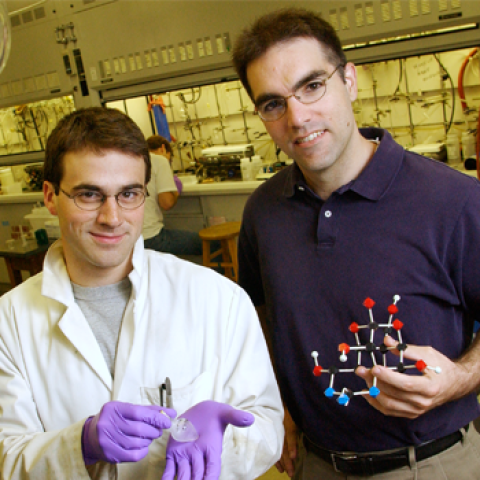Interdisciplinary Initiatives Program Round 4 – 2008
Sandip Biswal, Radiology
Justin DuBois, Chemistry
David Yeomans, Anesthesia
Pankaj Jay Pasricha, no longer at Stanford
Chronic pain is a major, universal health problem and is one of the most common reasons why people seek medical care. In the United States, an estimated 30 to 50 million Americans suffer from chronic pain. The societal annual cost is on the order of $100‐200 billion dollars and there is relatively large unmet clinical need in the management and care of chronic pain patients. The paucity of objective, diagnostic tests and a limited armamentarium of effective and safe medicines no doubt fuel the aggravation shared by chronic pain sufferers and their caregivers. Current clinical and medical imaging methods are very limited in identifying causes of chronic pain and pain syndromes. The main goal of this project is to develop a medical imaging study that would objectively highlight hypersensitive pain‐sensing nerves seen in chronic pain syndromes. The sensation of pain is ultimately dependent upon voltage‐gated sodium channels (NaV), which are essential to generation of action potentials and nerve impulse conduction. Certain NaV isoforms have been specifically associated with the sensation of pain and are known to be dynamically expressed in peripheral sensory neurons following neuronal or soft tissue injury. Understanding changes in NaV expression levels and location of these changes in intact living subjects in a controlled setting will not only provide significant insights into pain mechanisms but also facilitate imageguided therapies. To accomplish this, we will develop fluorescently‐labeled and radiolabeled saxitoxins (STX), a nonprotein neurotoxin that binds NaV channels with high affinity, and use them in conjunction with small animal imaging approaches already available in the Clark Center. The main purpose of this project is, therefore, to image, identify and directly treat NaV‐enhanced activated pain pathways in a variety living, longitudinal models of peripheral pain using STX‐based optical and radionuclide imaging approaches. To date, we have successfully synthesized 2 fluorescently‐labeled (FITC‐STX and Cy5‐STX) and a radiolabeled STX derivative ([18F]STX) and preliminarily imaged them in living models.
The success of this proposal thusfar has been dependent upon significant contributions from each member of our uniquely‐assembled multidisciplinary team. Justin DuBois, PhD, Brian Andresen, BS, and William Parsons, BS, are members of the Department of Chemistry and experts in the synthesis of STX, synthesis of fluorescently labeled analogs, studying its affinity for NaV isoforms and the structure of NaV. David Yeomans, PhD, Associate Professor of Anesthesia and Director of Pain Research, provides not only expertise in generating and assaying pain behaviors in animal pain models but also is an authority on NaV neurobiology and other pain‐related neuromolecular changes at the cellular and tissues level. Pankaj Jay Pasricha, MD, who has generated and characterized a unique model of chronic dyspepsia, will provide his models and knowledge of the molecular phenotype of this gastrointestinal pain disorder. Both Frederick Chin, PhD, Head of Cyclotron Radiochemistry, and Aileen Hoehne, PhD, have provided their advanced skills in preparing radiolabeled [18F]STX. Sandip Biswal, MD, and Deepak Behera DNB, have contributed experience in molecular imaging and image analysis of the peripheral nervous system in living models using a variety of dedicated molecular imaging devices. We ultimately hope this Bio‐X IIP‐funded work, which aims to develop methods to better diagnose and treat pain, will one day help and possibly treat individuals suffering from chronic pain with the novel compounds developed here.



